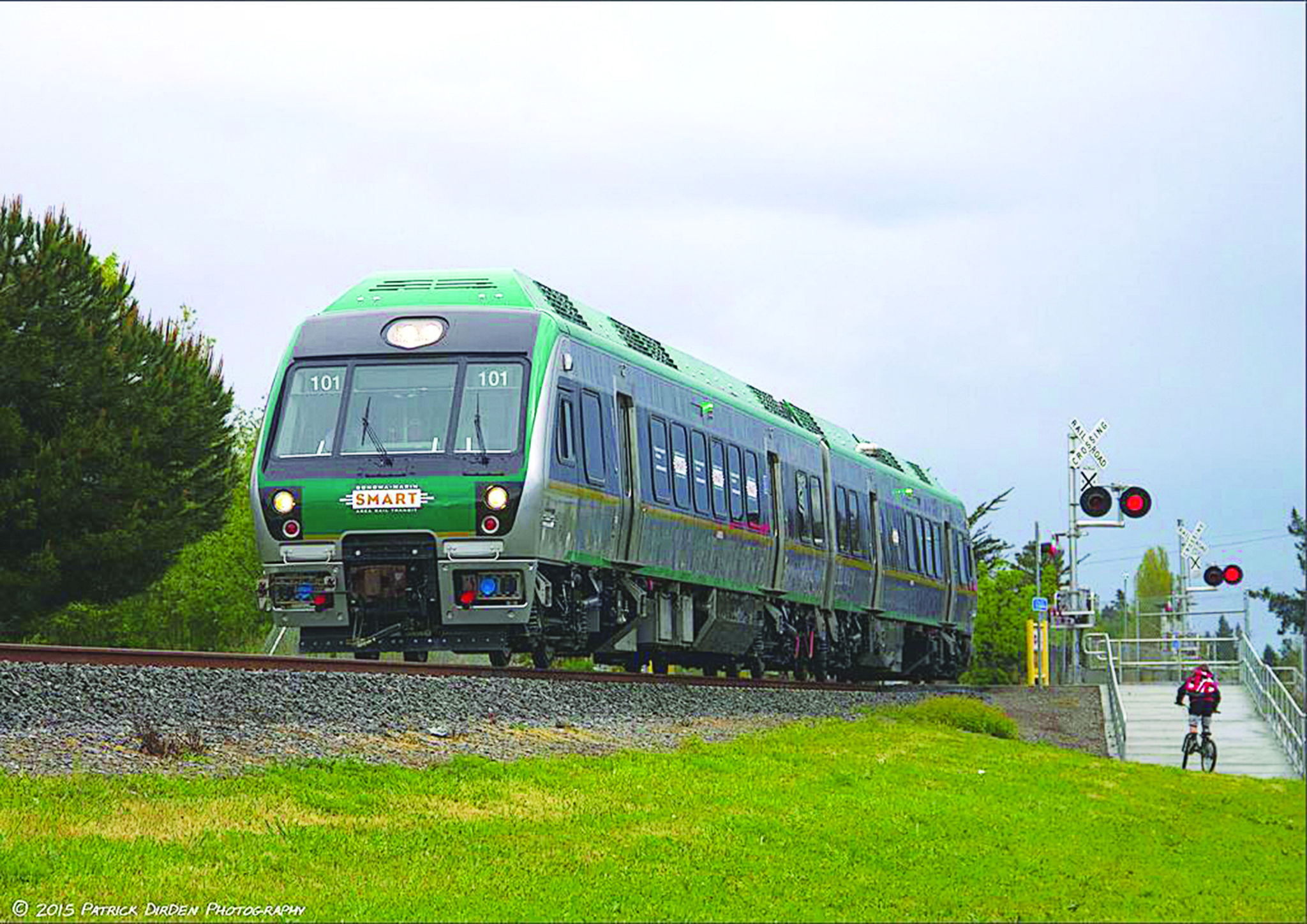By Chris Rooney
Even the most ardent supporter of a commuter train linking Sonoma County to central Marin County has to be feeling a little skeptical these days.
By now, according to the plan, Sonoma-Marin Area Rail Transit (SMART) was supposed to be actively moving people from Santa Rosa to San Rafael. But a December 2016 promise of service was postponed, vaguely, until “late spring.” There was also the promise that a quarter-cent sales tax would cover all expenses. SMART officials say there are no figures on what the delay will cost.
Meanwhile, empty trains roll up and down the North Bay, awaiting ticket-bearing customers while adding costs to an ambitious, $500 million build-out plan that’s already late to arrive, adding costs day by day. A public records request with SMART is pending and seeks information on how much the SMART District is laying out in payroll and other costs since December.
The train’s social media pages are meanwhile peppered with frustration from citizens weary of delays and budget crises: “Trains operating, yet still empty,” Jerry Gibson writes on Facebook. “Our tax dollars hard at work.” Missy LePoint writes: “SMART is dispensing advice on time-management? Hilarious. Just tell us the day that ‘late spring’ arrives, OK?”
Still, most who backed the popular SMART train proposal from the beginning are still on board. The train is wildly popular among the region’s political class, which has proposed it as a traffic-beating alternative HWY 101. None of the elected officials who championed SMART have publicly wavered despite delays and budget increases—not even Windsor Mayor Deb Fudge. She’s been on the SMART District Board since 2005, and in January was selected to head it.
Larkspur Vice Mayor Daniel Hillmer represents Marin County mayors and councilmembers on the SMART board. He’s pleased with the progress. “SMART is performing according to the Measure Q requirements, has balanced budgets and is on schedule,” Hillmer says, referring to the Marin measure that partially funded the train in 2008. “SMART continues to make significant progress in preparation for passenger service to begin in the late spring.”
Hillmer’s on-time optimism doesn’t jibe with what voters were promised when Measure Q appeared on the ballot nine years ago—a fully operational train ferrying riders from Cloverdale to Larkspur by 2014, paid entirely by a quarter-cent sales tax.
SMART spokeswoman Jeanne Mariani-Belding notes that a late-game engine snafu caused the latest delay as she concedes that “federal and regional grants” were called upon to keep the project alive when it became clear that the voter-approved tax was not going to be enough to foot the bill.
Expenses keep mounting—which puts more pressure on SMART to deliver a service with a budget that is contingent on ridership. Skeptics of SMART’s ticket-revenue estimates note that the maximum daily round-trip adult fare to ride the train’s entire route will be fixed at $23, and SMART is offering a slate of discount rates for regular commuters, seniors, youth and disabled passengers.
A quick history of SMART exposes a project facing imperilment from day one. Before there was Measure Q in 2008, there was Measure R in 2006, which failed to earn the two-thirds majority of combined votes between Sonoma and Marin counties. With the most to gain from a train offsetting Highway 101 gridlock, about 70 percent of Sonoma County backed Measure R, but skeptical Marin County voters doomed the proposed quarter-cent tax to pay for SMART.
SMART financing returned as Measure Q in 2008 and incorporated bicycle paths into the mix. That helped nab it the endorsement of the Marin Bicycle Coalition, among the area’s more vocal activist groups. Marinites again failed to deliver two-thirds support but overwhelming support in Sonoma County carried the day and the $500 million SMART commuter train was born—with a projected completion date by the end of 2014 and a promise to link Cloverdale to Larkspur, eventually.
But 2008 was more than SMART’s birthday—it also marked the onset of the Great Recession. Citing the economy’s downturn, the SMART District’s revised plan delayed northern Sonoma County SMART service in Healdsburg and Windsor—even as residents there said they needed a commuter train. At the Marin County end of the line, residents sparred with SMART over a proposed two-mile connector line from San Rafael to Larkspur—a key component in getting Bay Area commuters onto ferryboats.
That fight was settled recently with the help of North Coast Congressman Jared Huffman and the Larkspur railroad extension was OK’d with an expected opening in 2018. A faltering late-aughts economy also meant a decrease in tax revenues and pushed SMART’s opening to the end of 2016. But a July 2016 engine failure in a Toronto commuter-train system, which uses the same engine-car combination as SMART, pushed the opening into 2017, as all the SMART engines had to be replaced while SMART struggled to sort out problems with its warning systems.
“This new engine problem, and the need to complete our system-wide safety testing … has led me to the conclusion that beginning of passenger service by the end of 2016 is not advisable,” wrote SMART General Manager Farhad Mansourian in an October 2016 memo to SMART’s board. “We will be working even harder and target late spring 2017 as our beginning of passenger rail service.”
Mariani-Belding says that the system as a whole “is in the home-stretch of some important system-wide safety testing.”
The safety tests include the not-infrequent blaring of train horns, which have been met with complaints from residents near the tracks, an audible reminder that SMART is still not up and running.












Smart is not a bad “idea.” Smart has been badly implemented. Big difference.
My experience with SMART haters is that they are blinded by their hatred of the system for any number of reasons. They will often quote “statistics” that are correct, for example, Cal trans had compiled statistics of the numbers of daily drivers on Heatherton ave ( the Southern aimed off ramp into San Rafael from 101). The SMART hater stated, 200,000(+) drivers will be inconvenieenced by the arrival/departure of SMART trains in the central San Rafael station. Sounds reasonable, but if one thinks about this for more than 20 seconds, it becomes apparent that a train, leaving the station every 1/2 hour ( SMART’s Schedule) can only disrupt traffic flow for that many drivers, only if it blew up while crossing a street. Further, the signals along heatherton and all the other streets are coordinated ( to a varying degree), pedestrians crossing 4th, 5th/mission will delay traffic more than a SMART train crossing that same distance. And yet, no one is decrying the thoughtless predestrians daring to blatently cross the street. It’s clear that there are pleanty of detractors, how many, hard to tell. Others complain about the costs of SMART but, to date, SMART has only amassed a total debt load of less than 200 million dollars. SMART has constructed 43 miles of track, dozens of intersections, numerous bridge crossings, train yards, repair facilities, offices, personel, etc. Admittedly, as it’s currently constructed, SMaRT will never carry anywhere near the passenger load that BART does, but BART costs per mile start out at about 130 million per mile, to close to a billion dollars/mile ( admittedly mostly underground construction). SMaRT will, eventually get going and carrying passengers but they better get going soon because Measure Q expires in 2028.
Nice fantasy. Who is going to ride this thing? I know of no one but let’s play the game. Take your car to the parking garage (pay) take the shuttle to the train. Get on the train (pay) go to your get-off point, take a cab/bus/uber to your work (pay). Then to come home, do it all over again. Pay to get back to the train, pay to take the train, take the shuttle back to your car, now you can go home.
No thanks, I will take my car.
Eventually smart will be double tracked and electrified. There is a hard core of rightwing public transit haters who rant such things as “Boondoggle. No one will ride them. etc” When the system is in operation, these same people then complain that the trains are too-crowded.